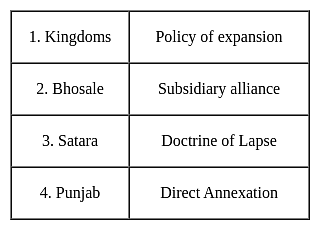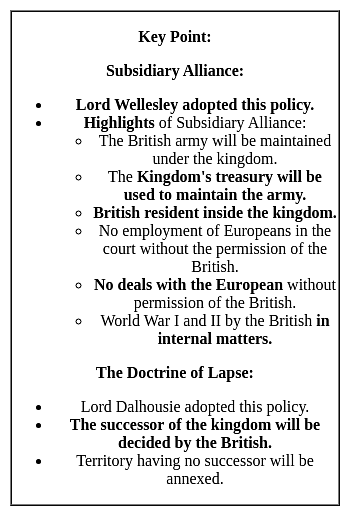TS SET Paper 2 Mock Test - 7 (History) - TS TET MCQ
30 Questions MCQ Test - TS SET Paper 2 Mock Test - 7 (History)
Consider the following statements about the Tebhaga Peasant Movement:
- The movement was an independence campaign initiated by the Gujarat Kisan Sabha
- The demand of the movement was to uproot of Zamindari system and the end of serfdom
Which of the above statements is/are correct?
Consider the following statements regarding the Home Rule Movement?
(1) Ineffective functioning of the INC was a major factor in the formation of Home Rule Leagues.
(2) The Tilak’s league was called the All India Home Rule League.
Select the correct answer using the code given below.
Match List I with List II, and select the correct answer by using the codes given below the lists:
FESTIVAL
1. Navreh
2. Cheti Chand
3. Ugadi
4. Rongali Bihu
PLACE
a. Assam
b. Sindh
c. Kashmir
d. Andhra Pradesh
Codes:
Consider the following statements about the Pandyan Kingdom:
1. The first time it was mentioned by Fa-Hien.
2. They used to earn profits by trading with the Roman empire.
Which of the above statements is/are correct?Which among the following sentence is incorrect about Rajadhiraja Chola I?
Consider the following statements:
1) The discussions in the Third Round Table Conference eventually led to the passing of the Government of India Act of 1935
2) The Government of India Act of 1935 provided for the establishment of All India Federation to be based on a Union of the provinces of British India and the Princely States
Which of the statements given above is/are correct?
Postmodern critiques of historical representation often rely on the concept of:
Which of the following were included in the fourteen points of Jinnah?
- Separate set of Fundamental Rights for Muslims
- Reservation of one Third of Seats for Muslims
- Separation of Sindh from Bombay
- One Third Muslim Ministers
Select the correct option from the codes given below:
Consider the following dynasties:
1. Pallavas of Kanchipuram
2. Imperial Cholas
3. Chalukyas of Badami
From the decline of Guptas until the rise of Harshavardhana in the early seventh century, how many of the kingdoms given above were holding power in Southern India?
Nalanda University was founded by which of the following ?
Who among the following was the President of the Muslim League in 1930?
Consider the following statements.
1. The Mughal emperors patronised the Dhrupad form of music.
2. Mughal miniature paintings give evidence that music was employed in Mughal courts.
Which of the above statements is/are correct?Which is that source which gives a lie to the tradition of a fratricidal war of Asoka?
In which of his edicts does Asoka express remorse for the sufferings caused by the Kalinga war?
In which of his following inscriptions did Asoka declare that all people were his children?
Consider the following events during India’s freedom struggle:
1) Chauri-Chaura Outrage
2) Minto-Morley Reforms
3) Dandi March
4) Montague-Chelmsford Reforms
Which one of the following is the correct chronological order of the events given above?
Consider the following pairs regarding British policies of expansion:

Which of the pairs are correctly matched?
Which of the following statement(s) about the India election of 1945 is/are correct?
1. Congress emerged as the largest party by capturing 52 of 109 seats in the Central Assembly.
2. Muslim league captured all the Muslim reserved seats in the Central Assembly.
3. In the provincial elections, the Muslim league got a majority in Bengal, Punjab, and Sindh.
Select the correct code from below:
Arrange the following Buddhist sects in chronological order:
(i) Hinayanists and Mahayanists
(ii) Sthaviravadins and Mahasanghikas
(iii) Vajrayanists
(iv) Sarvastivadins
Select the answer from the codes given below:
Statement (A) Ashvaghosha, a poet who composed a biography of the Buddha, the Buddhacharita, lived in the court of Kushans.
Statement (B) Mahayana believes in the heavenliness of Buddha and Idol worship of Buddha.
Statement (C) Bodhisattvas are supposed to be persons who had adopt Buddhism.
Which statement(s) is/are not true regarding Buddhism?
Which of the following statements about Ellora caves is correct?
- They were initially built by Saatavahanas.
- These caves belong to 6th to 10th century A.D.
- Unlike Ajanta caves, these caves are dedicated to only one religion, i.e., Buddhism.
Select the correct answer using the codes given below:
From the decline of Guptas until the rise of Harshavardhana in the early seventh century, which of the following rulers were holding power in Northern India?
1. Mahasena Gupta of Magadha
2. Siyaka of Paramaras
3. Prabhakarvardhana of Pushyabhutis
4. Grihavarman of Maukharis
5. Bhillama V of Yadavas
6. Dhruvasena II of Maitrakas
Select the correct answer using the codes given below.
Match List I with List II, and select the correct answer by using the codes given below the lists:
LIST - I (Sadanga of Indian Painting)
1. Sadrisyam
2. Lavanya Yojanam
3. Varnikabhanga
4. Pramanam
LIST – II (Meaning)
a. Correct perception, measure and structure
b. Similitude
c. Infusion of grace, artistic representation
d. Artistic manner of using the brush and colours
Codes:
Which act extended the principle of communal representation by providing separate electorates for depressed classes?



















